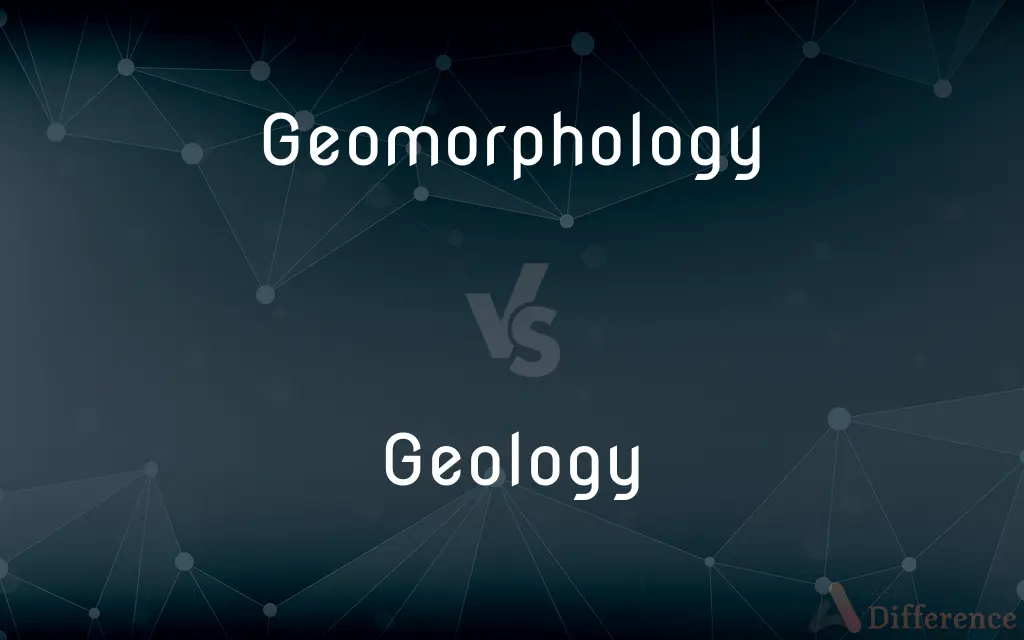Geomorphology vs. Geology — What's the Difference?
By Tayyaba Rehman & Fiza Rafique — Updated on March 15, 2024
Geomorphology focuses on the study and analysis of Earth's landforms and the processes shaping them, while geology encompasses the broader study of the Earth, including its materials, processes, and history.

Difference Between Geomorphology and Geology
Table of Contents
ADVERTISEMENT
Key Differences
Geomorphology is the scientific study concentrating on the shapes of Earth's surface, examining how landscapes evolve through processes like erosion, sedimentation, and tectonic activities. It delves into understanding the reasons behind various landform formations and their changes over time. On the other hand, geology deals with a wider scope, including the study of rocks, Earth's interior, and the processes by which the Earth has evolved over billions of years. It encompasses not only the surface but also the materials and mechanisms deep beneath it.
While geomorphologists might study the formation of a river valley to understand erosion patterns, geologists might focus on the types of rocks in the valley and their origins. Geology therefore provides the foundational knowledge of the materials and processes that geomorphology builds upon to understand surface processes and landform dynamics.
Geomorphology often uses tools and methods like GIS (Geographical Information Systems) and remote sensing to map and analyze landforms, emphasizing the current landscape and its recent changes. Geology, whereas, frequently employs techniques like radiometric dating and analysis of rock strata to understand Earth's history and its long-term changes.
In the context of environmental and climate change studies, geomorphology offers insights into landform responses to climate variations and human activities. In contrast, geology provides a broader perspective on Earth's resources, such as minerals, oil, and gas, and their sustainable extraction and management.
Both fields, while distinct, are interdependent. Geomorphology's focus on surface processes and landforms is enriched by geological insights into rock types, earth materials, and historical geology, which help explain why the landscape looks the way it does. Conversely, geological studies often incorporate geomorphological evidence to reconstruct Earth's past environments and climatic conditions.
ADVERTISEMENT
Comparison Chart
Focus
Study of Earth's landforms and the processes shaping them.
Study of the Earth, its materials, processes, and history.
Scope
Primarily surface processes and landforms.
Broad, including Earth's interior, materials, and entire history.
Methods
GIS, remote sensing, field mapping.
Rock strata analysis, radiometric dating, mineralogy.
Application in Climate Change
Assessing landform responses to climate variations.
Understanding Earth's resources and their management.
Interdisciplinary Connections
Links closely with physical geography and environmental science.
Connects with physics, chemistry, and environmental science.
Compare with Definitions
Geomorphology
The study of Earth's landforms and the processes that shape them.
Geomorphologists analyze mountain erosion to predict future landscape changes.
Geology
The science of Earth, covering its materials, history, and processes.
Geologists study rock formations to understand Earth's history.
Geomorphology
Uses tools like GIS for mapping and analysis.
GIS technology helps in the identification of ancient flood plains through geomorphology.
Geology
Explores the processes leading to Earth's formation and evolution.
Plate tectonics theory, a cornerstone of geology, explains the movement of Earth's plates.
Geomorphology
Focuses on understanding the formation and evolution of landscapes.
Studying river meanders in geomorphology reveals patterns of water flow and sediment deposition.
Geology
Involves studying fossils to reconstruct past environments.
Paleontology, a part of geology, uses fossils to understand prehistoric life.
Geomorphology
Examines natural hazards like landslides and erosion.
Geomorphology can predict areas at risk of landslides by analyzing slope stability.
Geology
Aids in the exploration of natural resources.
Geologists locate oil reserves by interpreting subsurface geological structures.
Geomorphology
Interprets past climates through landform analysis.
Desert dunes provide clues about past wind patterns and climatic conditions in geomorphology.
Geology
Investigates the composition and structure of minerals and rocks.
Mineralogy, a branch of geology, categorizes minerals by their chemical composition.
Geomorphology
Geomorphology (from Ancient Greek: γῆ, gê, "earth"; μορφή, morphḗ, "form"; and λόγος, lógos, "study") is the scientific study of the origin and evolution of topographic and bathymetric features created by physical, chemical or biological processes operating at or near the Earth's surface. Geomorphologists seek to understand why landscapes look the way they do, to understand landform and terrain history and dynamics and to predict changes through a combination of field observations, physical experiments and numerical modeling.
Geology
Geology (from the Ancient Greek γῆ, gē ("earth") and -λoγία, -logia, ("study of", "discourse")) is a branch of Earth science concerned with the solid Earth, the rocks of which it is composed, and the processes by which they change over time. Geology can also include the study of the solid features of any terrestrial planet or natural satellite such as Mars or the Moon.
Geomorphology
The study of the evolution and configuration of landforms.
Geology
The science which deals with the physical structure and substance of the earth, their history, and the processes which act on them.
Geomorphology
The study of landforms, their classification, origin, development, and history.
Geology
The scientific study of the origin, history, and structure of the earth.
Geomorphology
The branch of geology that studies the characteristics and configuration and evolution of rocks and land forms
Geology
The structure of a specific region of the earth's crust.
Geology
A book on geology.
Geology
The scientific study of the origin, history, and structure of the solid matter of a celestial body.
Geology
The science that studies the structure of the earth (or other planets), together with its origin and development, especially by examination of its rocks.
Geology
The geological structure of a region.
The geology of the Alps.
Geology
The science which treats: (a) Of the structure and mineral constitution of the globe; structural geology. (b) Of its history as regards rocks, minerals, rivers, valleys, mountains, climates, life, etc.; historical geology. (c) Of the causes and methods by which its structure, features, changes, and conditions have been produced; dynamical geology. See Chart of The Geological Series.
Geology
A treatise on the science.
Geology
A science that deals with the history of the earth as recorded in rocks
Common Curiosities
Can geomorphology and geology be studied together?
Yes, both fields are interrelated and often studied together to gain a comprehensive understanding of Earth's surface and subsurface dynamics.
Why is GIS important in geomorphology?
GIS is crucial in geomorphology for mapping, analyzing, and visualizing landforms and surface processes on Earth.
How do geomorphologists study climate change?
Geomorphologists study changes in landforms and surface processes as indicators of past and present climate changes.
Can geomorphology help predict natural disasters?
Yes, geomorphology can help predict natural disasters by analyzing landform stability and identifying risk areas for landslides, floods, and erosion.
What does geology study?
Geology studies the Earth, its materials, processes, history, and how these elements interact.
What role does radiometric dating play in geology?
Radiometric dating is key in geology for determining the age of rocks and fossils, helping to reconstruct Earth’s history.
What is geomorphology?
Geomorphology is the study of landforms, their processes, forms, and sediments at the surface of the Earth.
How do geomorphology and geology differ in focus?
Geomorphology focuses on surface processes and landforms, while geology covers a broader spectrum including Earth’s materials, internal processes, and history.
What is the significance of rock strata in geology?
Rock strata provide valuable information about Earth’s past environments, climate, and biological evolution.
How does geology contribute to natural resource management?
Geology provides insights into the location, extraction, and management of Earth’s natural resources, such as minerals, oil, and gas.
Share Your Discovery

Previous Comparison
Execute vs. Run
Next Comparison
Swab vs. SwapAuthor Spotlight
Written by
Tayyaba RehmanTayyaba Rehman is a distinguished writer, currently serving as a primary contributor to askdifference.com. As a researcher in semantics and etymology, Tayyaba's passion for the complexity of languages and their distinctions has found a perfect home on the platform. Tayyaba delves into the intricacies of language, distinguishing between commonly confused words and phrases, thereby providing clarity for readers worldwide.
Co-written by
Fiza RafiqueFiza Rafique is a skilled content writer at AskDifference.com, where she meticulously refines and enhances written pieces. Drawing from her vast editorial expertise, Fiza ensures clarity, accuracy, and precision in every article. Passionate about language, she continually seeks to elevate the quality of content for readers worldwide.
















































